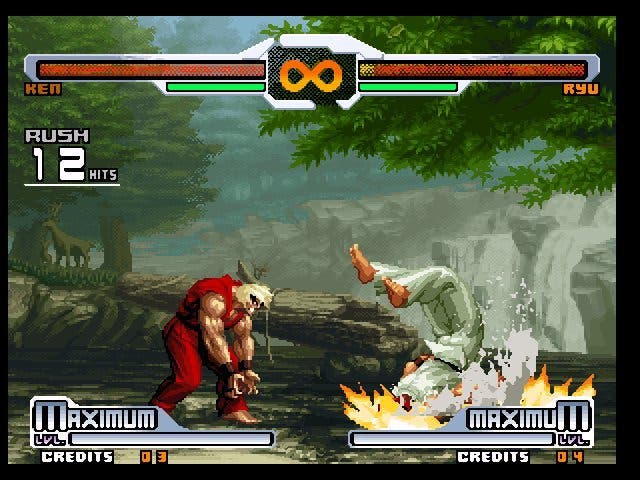Retrospective: Street Fighter
20 years of beat-'em-ups picked thoroughly apart.
Capcom vs. SNK
Series:
(2000) Capcom vs. SNK: Millennium Fight 2000, (2001) Capcom vs. SNK: Millennium Fight 2000 Pro, (2001) Capcom vs. SNK 2: Mark of the Millennium 2001, (2003) SNK vs. Capcom: SVC Chaos
CvS Mechanics:
- Ratio Match - we always suspected that Sagat was a better fighter than Sakura
- Groove Selection - play the game system you prefer
If you'd suggested to anyone during the Street Fighter II heyday that Capcom and SNK would one day join forces and produce a Capcom vs. SNK crossover game, they would have had you committed. The sheer concept back then was as ludicrous as a Mario and Sonic game. Well, we've all learnt a lot since then, and not only did Capcom vs. SNK come to pass, but it did it twice after that too.
The first fully-fledged game in the series, Capcom vs. SNK: Millennium Fight 2000 (I've never played SNK vs. Capcom: The Match of the Millennium on the Neo-Geo Pocket, although other Eurogamers tell me it was good) was developed by Capcom. Rather than the normal six-button affair, Capcom scrapped the mediums and used light and heavy attacks like many of SNK's fighters. The roster was comprised of characters from Street Fighter, Morrigan from Darkstalkers and many SNK fighters from the likes of The King of Fighters.
The game's most interesting feature was the Ratio system. Each character was tiered between one to four depending on their general power and effectiveness - Cammy and King were tier one, Balrog and Terry Bogard were tier two, bosses Vega and Geese Howard were tier three and uber bosses Evil Ryu and Orochi Iori were top tier four. Players could therefore assemble teams of one to four characters. Watching Blanka, Dhalsim, Yuri and Vice trying to take down the all mighty Akuma was amusing indeed.

Rather than limiting Millennium Fight to Alpha-styled play mechanics, Capcom gave players the option of a Capcom or SNK Groove. Capcom Groove was more or less pure Alpha, with three levels of Super charged by attacking or blocking. SNK Groove was similar to the Extra Mode from The King of Fighters '98. It required the player to manually charge their single-tiered Super meter - extra powerful Supers, known as Super Desperation Attacks, were also available with a full Super meter and low health.
Millennium Fight proved highly successful in the arcades, bringing fans of Capcom and SNK fighters together - although most would generally play games from both companies anyway. A minor update in Millennium Fight 2000 Pro was followed by Capcom vs. SNK 2: Mark of the Millennium 2001.
Mark of the Millennium was again developed by Capcom, who this time decided that its six-button system was better and thus reinstated the mediums. Most players' criticism with the previous games' Ratio system was that it wasn't massively accurate in determining power and didn't allow for certain dream match-ups. In came Capcom with the Free Ratio system. This time players determined the ratio for each character rather than it being preset - so you could effectively have a tier-four-powered Dan.
Mark of the Millennium also significantly upped the character count with new inclusions like Kyosuke from Capcom's Rival Schools and Hibike Takane from Last Blade 2. Mark of the Millennium also saw the return of Shin Akuma as a secret boss along with Ultimate Rugal - Rugal having absorbed Akuma's Dark Hadou.

Capcom also upped the customisation by adding four further Grooves. A-Groove used a system similar to the V-ism Custom Combos from Alpha, P-Groove was limited to level-three Supers and used the parrying system from Third Strike, N-Groove was a more classic King of Fighters style and K-Groove worked like a combination of Samurai Shodown's Rage Gauge and Mark of the Wolves' Just Defend system. Only Marvel vs. Capcom 2 can really challenge Mark of the Millennium for its level of diversity.
Playmore took the reigns for the final SNK Capcom title, SNK vs. Capcom: SVC Chaos (it seems the developer gets to have its name in the title first). Chaos is an SNK game through and through, and was produced on SNK's archaic AES hardware. Even though Playmore crammed every last drop of graphical performance out of the AES, Chaos still looks dated alongside Mark of the Millennium - although I have to admit I do prefer the 2D backgrounds in Chaos.
Chaos returned to the four-button setup SNK always championed and also completely removed the Tag and Groove Selection systems. In most respects Chaos is more a spiritual sequel to Mark of the Millennium and mechanically shares little in common - playing more like The King of Fighters 2002 with bonus Capcom characters. This was by no means a bad thing as the game still played well with its extra-powerful Exceed Supers. Street Fighter diehards had to adjust their fighter skills to the comparatively faster King of Fighters pacing.
In the same way Ryu has his Evil Ryu alter-ego, SNK also saw fit to give Ken a Violent Ken variation for Chaos - his Exceed animation had a similar feel to angry Orochi Iori. Extra fan-service was added with hundreds of fighter dialogues that pre-empted each match, with Dan repeatably being mistaken for Ryo and Robert. More hilarious still was Darkstalkers' resident vampire Demitri and his Midnight Bliss Super. Said Super turns any male opponent into a woman before Demitri bleeds them dry. Apparently the Japanese actually have miniature figures dedicated to this alone.








